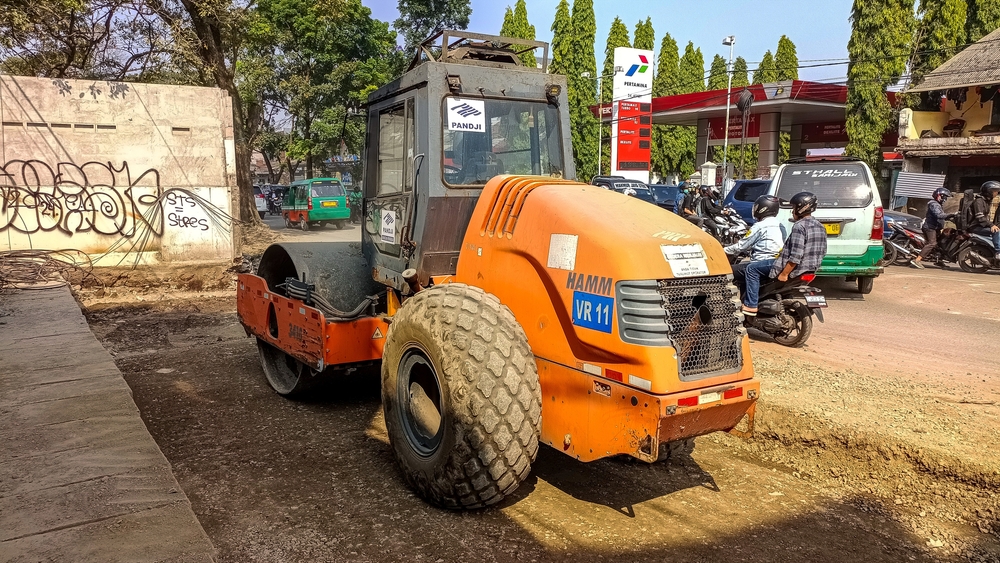Introduction
Excavators stand as pivotal machinery, driving projects towards completion with efficiency and precision. From the foundational trenches of new developments to the demolition of obsolete infrastructures, excavators facilitate a breadth of tasks that underpin the construction industry.
This guide aims to demystify the concept of excavators for beginners, providing a comprehensive overview of their types, functions, and essential features. Join us as we navigate through the complexities of excavators, offering insights into their operational dynamics, utility across various construction scenarios, and the maintenance ethos essential for their longevity.
What is an Excavator?
At its core, an excavator is a heavy construction equipment piece designed for digging, lifting, and moving materials, which is vital across a myriad of construction tasks. Its primary function revolves around earthmoving, making it a staple in projects ranging from trench digging for pipelines to material handling and demolition. The versatility of excavators extends to applications in mining, forestry, and even landscaping. This adaptability is what makes excavators a cornerstone in the construction industry, capable of transforming landscapes and facilitating development.
Types of Excavators
Excavators come in various shapes and sizes, each tailored to specific project requirements and operational environments. The categorization of excavators is based on their size, functionality, and applications, which include:
- Mini Excavators: Compact and highly maneuverable, these are perfect for tight spaces and smaller projects.
- Crawler Excavators: Known for their tracked design, these are ideal for hilly terrain and offer superior stability.
- Wheeled Excavators: Best suited for urban environments, their wheeled structure allows for quicker movement on roads.
Each type serves a unique purpose, from the mini excavators designed for minor excavations and landscaping to the robust crawler excavators specializing in heavy-duty digging and demolition tasks.
Components and Parts
The anatomy of an excavator is a marvel of engineering, comprising several key components that work in unison to perform a variety of construction tasks. Each component is crucial for the excavator’s functionality, contributing to its versatility and efficiency.
- Boom: The boom is the excavator’s most visible feature, an adjustable arm that provides the height and reach necessary for various tasks. It’s connected to the excavator’s body and can move up or down, offering flexibility in operation.
- Arm (or Stick): Extending from the boom, the arm is pivotal for digging depth. It moves the bucket into and out of excavation sites, enabling precise control over digging and material handling operations.
- Bucket: The business end of the excavator, the bucket is designed for excavation and material removal. Buckets come in different shapes and sizes, tailored to specific tasks such as digging, grading, or trenching.
- Hydraulic System: This system is the lifeblood of the excavator, powering its movements through hydraulic fluid under pressure. It consists of pumps, motors, and valves that translate the operator’s commands into smooth, coordinated movements of the boom, arm, and bucket.
- Undercarriage: For crawler excavators, the undercarriage includes tracks that provide stability and mobility over rough terrain. Wheeled excavators, on the other hand, have a chassis equipped with wheels for faster movement on paved surfaces.
- Cabin: The operator’s command center, equipped with controls and displays for operating the excavator. It’s designed for comfort and safety, offering visibility of the work area and ergonomic controls for precise maneuvering.
Understanding these components is essential for operators to maximize the excavator’s capabilities, ensuring efficient and effective use in various construction tasks.
How Does an Excavator Work?
The operation of an excavator is a sophisticated process that combines mechanical and hydraulic principles, orchestrated by the skilled hands of the operator. The heart of this machinery lies in its hydraulic system, which springs into action upon the operator’s command. As the operator engages the controls, hydraulic pumps channel fluid under high pressure through a network of valves to the hydraulic motors and cylinders. This intricate system transforms hydraulic energy into the mechanical force that animates the boom, arm, and bucket, allowing for precise and powerful movements.
Central to the excavator’s functionality is its control system, which typically consists of joysticks, pedals, and switches, designed for intuitive operation. Through simple movements of these controls, the operator can execute complex tasks effortlessly. For instance, advancing a joystick may extend the arm outward, while pulling it back retracts the arm, and a lateral movement might swivel both the cabin and boom, enabling work from various angles without repositioning the machine.
The core activities of digging and lifting are carried out with remarkable precision, thanks to the operator’s ability to finely tune the force and angle of the bucket. Whether it’s excavating a site for a new foundation, grading land, or loading materials onto transport vehicles, the excavator’s design allows for versatile application across multiple tasks. Additionally, the capability of the cabin and boom to rotate a full 360 degrees enhances the machine’s flexibility, permitting the operator to tackle projects from any direction, further augmented by the mobility afforded by the excavator’s undercarriage.
This seamless integration of hydraulic power, controlled movements, and mechanical versatility is what enables excavators to perform a wide array of construction tasks efficiently and effectively, making them indispensable on any construction site.
Applications in Construction
Excavators are among the most versatile pieces of construction equipment, used in a vast array of projects to achieve different objectives. Their applications in construction are diverse, including:
- Earthmoving and Grading: Excavators are fundamental for moving large quantities of earth, shaping land to specific contours for construction foundations, landscaping, and road building.
- Demolition: Equipped with specialized attachments like breakers and crushers, excavators can efficiently tear down buildings, bridges, and other structures, clearing the way for new construction.
- Material Handling: With the use of grapples and other attachments, excavators can handle and move bulky materials such as logs, pipes, and steel beams, facilitating the construction process.
- Utility and Pipeline Trenching: Excavators are essential for digging trenches for utility lines, sewers, and water pipes, offering precision and speed that manual labor cannot match.
- Mining and Quarrying: In mining operations, excavators are used to remove overburden, extract mineral resources, and manage waste material, contributing significantly to the efficiency of mining projects.
- Forestry Work: With appropriate attachments, excavators can assist in forestry operations, including clearing land, removing stumps, and managing vegetation.
Excavator Safety Tips
Operating an excavator, while pivotal for construction, demands a high level of awareness and adherence to safety protocols to protect both the operator and those on the construction site. Beyond conducting pre-operation checks and maintaining clear communication, there are several additional safety measures that must be emphasized:
Proper Training: Operators should receive comprehensive training on the specific model of excavator they will be using, including understanding its operational limits, safety features, and emergency procedures. This training ensures that operators are equipped with the knowledge to handle the machinery safely and efficiently.
Awareness of Surroundings: Operators must be constantly vigilant of their environment, including the presence of other workers, overhead power lines, and underground utilities. Awareness extends to the machine’s swing radius, ensuring no one is in harm’s way during operation.
Use of Personal Protective Equipment (PPE): Safety helmets, high-visibility clothing, steel-toed boots, and hearing protection are essential for operators and anyone in the vicinity of the operation area to minimize the risk of injury.
Routine Safety Meetings: Regular meetings to discuss safety protocols, potential hazards, and recent incidents can foster a culture of safety and vigilance among the crew.
Secure Entry and Exit: Ensuring that the excavator is stable and that access systems (such as steps and handrails) are used correctly can prevent falls and injuries.
Emergency Shutdown Procedures: Operators should be familiar with and able to execute emergency shutdown procedures swiftly to mitigate risks in unforeseen situations.
By integrating these safety tips into daily operations, the risk of accidents and injuries can be significantly reduced, promoting a safer work environment for everyone involved.
Maintenance and Care
Maintaining an excavator in peak condition extends beyond following the manufacturer’s recommended maintenance schedule and ensuring the machine is cleaned after use. A comprehensive approach to maintenance and care involves several critical practices that, when performed regularly, significantly enhance the operational life and efficiency of the excavator.
One of the cornerstones of excavator maintenance is the regular lubrication of its moving parts. This practice reduces wear and tear, ensuring that components such as joints and bearings operate smoothly. The frequency of lubrication should align with the guidelines provided by the manufacturer, tailored to the excavator’s specific model and usage patterns.
For those operating crawler excavators, attention to the track system is essential. Proper inspection and adjustment of track tension prevent slippage and damage, maintaining the excavator’s stability and performance. Conversely, those utilizing wheeled excavators must not overlook tire maintenance. Regular inspections are necessary to assess wear levels and ensure tires are correctly inflated, thus safeguarding mobility and safety.
The hydraulic system, the heart of the excavator’s operation, demands vigilant monitoring. Operators should routinely check for leaks, maintain optimal fluid levels, and replace hydraulic filters as required. This vigilance ensures the system’s efficiency and prevents potential failures that could impede performance.
Engine and cooling system maintenance are equally crucial. Regular engine checks help identify signs of wear, and timely oil changes, along with cooling system inspections, prevent overheating and potential engine failures. These measures are vital for sustaining the engine’s longevity and ensuring reliable operation.
Finally, the care of attachments cannot be overstated. Each attachment, depending on its function and frequency of use, has specific maintenance guidelines that should be meticulously followed. Proper care of attachments not only ensures their efficient performance but also extends their service life, contributing to the overall productivity of the excavator.
Conclusion
Excavators are more than just machines; they are integral components of the construction industry, facilitating a wide range of tasks from earthmoving to demolition. Understanding their types, functions, and maintenance requirements can significantly impact the success of construction projects. Whether you’re a beginner or looking to expand your knowledge, we hope this guide provides valuable insights into the world of excavators. For those eager to delve deeper or in need of specific construction solutions, ESP Ltd stands ready to assist, offering comprehensive construction requirements for clients across the globe.









